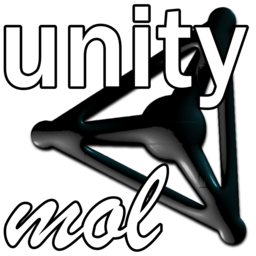pre-v0.9.5
Tutorial 1 - running UnityMol from the editor
- load
share/caffeine.pdb
- show game vs. scene windows
- displace an atom manually in the editor
- show inspector
- change its size
- generate a surface
- and modify its properties,
- delete it at the end
- change the aspect of an atom, e.g. transform into a cube
Tutorial 2 - UnityMol Field lines
(Part 1)
- load
samples/fieldline/fieldlines.pdb
- hide HyperBalls (
Hide button)
- show fieldlines menu (
Electrostat. menu), customize options
- for ex.
Speed=1, Density=1, Width=0.5, Length=0.9
(Part 2 : when running in Unity3D/editor)
- explain project hierarchy menu
- hide surface
- edit field lines manually (delete unwanted)
- re-display surface
(Part 3 : other visualizations of electrostatics)
- close field lines by clicking on
Field Lines button
- select
Volumetric Fields button
- in
Surface menu, toggle surface to hide
- in
Secondary Structures menu, enable sec. structures
(Part 4 : isosurface visualization)
- hide volumetric fields by clicking the button again
- Set both isosurface sliders to
T: -5.0 and T: 5.0
Load Pos. and Load Neg.- Add molecule surface via
Surface menu
- Apply a nice texture to this surface
- Apply a static cut to the surface to look inside
Tutorial 3 - UnityMol Sugar molecules
- load
share/Sugars/Case_9.pdb
- explain complexity
- change metaphor to licorice
- add sugar planes as first identification (
Sugar menu, option RingBlending)
- show SugarRibbons and combinations
- add sugar side-chains, hide hydrogens (deselect
Hide option on the left, activate hide hydrogens in sugar submenu)
- add oxygens (in the
Tune submenu)
- play with hyperballs coloring, e.g. by chain (Panel menu
Chains option) or Sugar
Tutorial 4 - UnityMol GLIC visualization
- load
samples/3EI0.pdb or 3EAM.pdb
- show chain coloring with hballs
- look down channel
- generate surface & color by chain
- apply lit spheres texture to surface
- generate B-factor surface @ 4.0
- color by B-factor
- superpose secondary structure
- hide hyperballs
Tutorial 5 - UnityMol Guided Navigation
(see e.g. the following paper for more details: M. Trellet, N. Ferey, M. Baaden, P. Bourdot: "Content and Task Based Navigation for Structural Biology in 3D Environments". IEEE VR 2015, Arles)
Set up a compatible example system
- load
samples/3EI0.pdb
- activate Guided Nav /
Send
- add a background through
Advanced menu>BackGround=Yes
- color by chain (
Panel menu > Chains option)
Guided navigation functionalities
- exploration around guides
i toggles internal/external position- arrow left/right up/down ;
- automated exploration
u/j automated pathway around the molecule ;
- symmetry-exploited navigation
- jump monomer-monomer:
m + arrows ;
- spreading
+/-/* or b/v/t for multi-level spreading ;
- auto-generated path following
Tutorial 6 - UnityMol Joypad Navigation
- load
adepth/1ay1.pdb
- activate Advances/Ambient Occlusion
- navigate, zoom, rotate with joypad
- change viz mode
Tutorial 7 - Explore sweet (sugar) molecules
- Sample data can be found in the
share/Sugars/ directory.
- All PDB files in that directory are sugar molecule pdb examples.
- Just open any of the files in UnityMol and explore the numerous options in the
Sugar menu and its submenus
- Normally all Sugar menu functions should work on them.
File overview:
Case_9 is the most complex example of a sugar, with several chain, several units, and several sugar types.Case_8 is an example with furanose and pyranoseCase_51 is a simple example with 3 glucoseCase_52 is a simple glucose helixCase_53 is a double glucose helixcase_5 is an Arabose example (1 sugar)case_32 is a beautifully simple example with 5 different sugars (with 5 different colors) and 2 chains (one ramification)
- Todo:
- Add a more complex protein-sugar complex sample PDB file to the
share/Sugars directory.
